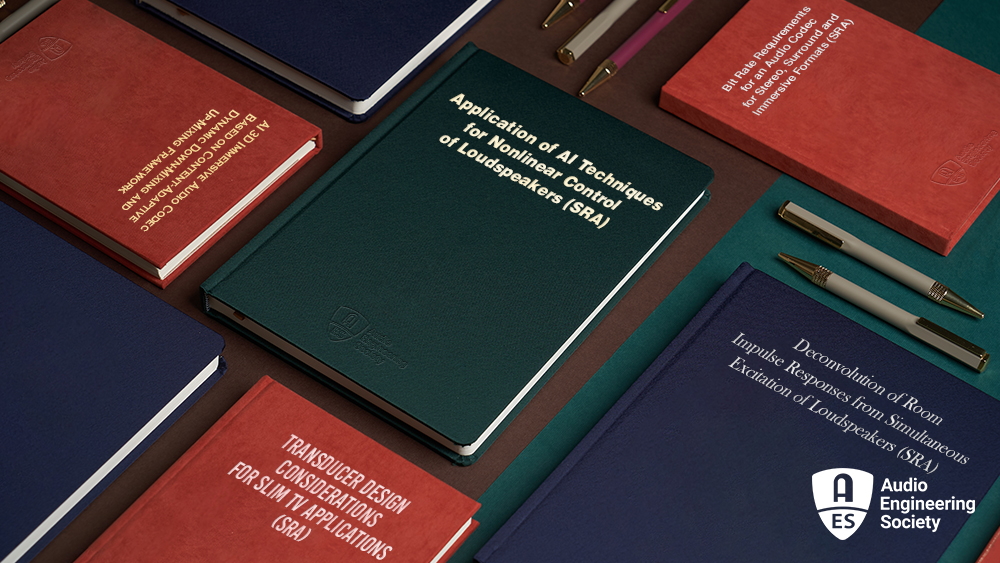Audio Engineering Society Recognized Samsung’s Audio Technological Prowess
Samsung Electronics has once again had its status as a trailblazer in the technological arena confirmed as 5 of the top 10 papers selected to be highlighted at the 2021 Fall convention of the Audio Engineering Society (AES) were those submitted by the company’s top research teams. Headquartered in New York, United States, AES is the world’s most prestigious international academic conference in the audio technology and engineering fields.
The five papers selected for AES’ esteemed ‘Top 10’ list this year were submitted by the Samsung Research (SR) 1 Visual Technology Team and Samsung Research America (SRA)’s Audio Lab.
Read on to learn more about the industry-leading papers submitted by Samsung to have received the Top 10 accolade this year.

① A Study in AI for Bass Extension and Distortion Reduction in Loudspeakers (SRA)
The most downloaded paper from this Fall’s AES conference, SRA’s paper entitled ‘Application of AI Techniques for Nonlinear Control of Loudspeakers’, continues the team’s work into bass extension and distortion reduction.
The paper posits that, in order to obtain high loudness that features good bass extension, low distortion and mechanical protection, the motion of the loudspeaker’s diaphragm needs to be accurately controlled.
SRA’s study presents a novel approach to solving these issues that harnesses a neural network to directly map the loudspeaker’s diaphragm displacement to the input voltage, allowing for the loudspeaker to be ‘inverted’. This technique not only allows control and linearization of the loudspeaker without theoretical assumptions, but it is also simpler to implement.
② Developing a Method To Measure Multiple Loudspeakers Simultaneously (SRA)
SRA’s second Top 10 paper, titled ‘Deconvolution of Room Impulse Responses From Simultaneous Excitation of Loudspeakers’, presents a method that allows for the measuring of several loudspeakers in a room simultaneously that reduces the measurement time, compared with typical immersive audio systems, by a factor of ten.
Traditional room-equalization involves exciting one loudspeaker at a time and then de-convolving the loudspeaker-room response from the recording. As the number of loudspeakers and positions within a room increases, the time required to measure loudspeaker-room responses therefore also increases. Therefore, SRA’s paper presents a technique to deconvolve impulse responses after exciting all loudspeakers at the same time.
③ Optimizing the Integration of Audio Systems Into Slim TVs (SRA)
Along with the development of new space-efficient display technologies in recent years has come the trend to decrease the overall size of consumer electronics, including televisions. In order to combat the physical limitations for audio technology development brought about by these designs, SRA has produced their AES Top 10-certified paper titled ‘Transducer Design Considerations for Slim TV Applications’.
The slim TV form factor brought about by industry trends creates a challenge for the design of integrated audio systems as it severely limits the physical performance possibilities of any acoustic transducer. For the most part, modern DSP (Digital Signal Processor) and amplifier technologies have been able to utilize the transducer up to its performance limits and thus maintain audio quality. However, if further thickness reduction of the TV is desired, these technologies will no longer be enough. SRA’s paper discusses the physical limits of current designs and suggests a new layout of a moving coil-transducer for ultra-slim device applications.
④ Discovering the Best Audio Codec for HDR10+ (SRA)
As we move into the HDR10+ era, SRA has been conducting research into the preferred audio codec for HDR10+, resulting in this accolade-winning paper, ‘Bitrate Requirements for an Audio Codec for Stereo, Surround and Immersive Formats’.
The paper shows that the Opus codec would be an excellent choice as the preferred audio codec for HDR10+. The team conducted three listening tests on Opus encoded stereo, 5.1 and 7.1.4 channel content taken from music, cinematic and EBU files encoded at bitrates of 32, 48 and 64 kbps per channel. Current Opus encapsulation in Ogg does not support 7.1.4 with stereo pairing. Therefore, the paper proposes a new stereo pairing schema to accommodate 7.1.4 content in Opus with joint stereo encoding. The results of the study conducted indicate that a bit rate of 64 kbps per channel or higher is required for transparency in stereo, but 48 kbps per channel may be sufficient for 5.1 and 7.1.4 audio formats.
⑤ Developing AI-Based 3D Audio Codec for High-Immersion in OTT Service Environment (SR)
As growing trends indicate that users’ preferred media consumption platform has shifted from cinema or broadcast channels to over-the-top (OTT) services, SR’s paper, titled ‘AI 3D Immersive Audio Codec Based on Content-Adaptive Dynamic Down-Mixing and Up-Mixing Framework’, proposes new 3D immersive audio codec that can support various spatial audio formats for multiple loudspeaker layouts accessible in OTT service environments.
Unlike conventional technologies that use a fixed mixing profile regardless of content type and characteristics, SR proposes a framework that variably applies the determined mixing/de-mixing profile by dynamically performing audio scene classification and spatial energy distribution characteristics analysis based on AI technology. It was also shown through a listening evaluation that the proposed one can provide a higher immersion than the conventional method even in a home entertainment OTT service environment.
1 Samsung Electronics’ advanced R&D hub, which leads the development of future technologies for its Device eXperience division
TAGSAESAES 2021AIAI Into the FutureAudioHDR10+loudspeakersSamsung Audio LabSamsung ResearchSamsung Research AmericaSRA
Corporate > Technology
Products > TVs & Displays
For any issues related to customer service, please go to
Customer Support page for assistance.
For media inquiries, please click Media Contact to move to the form.